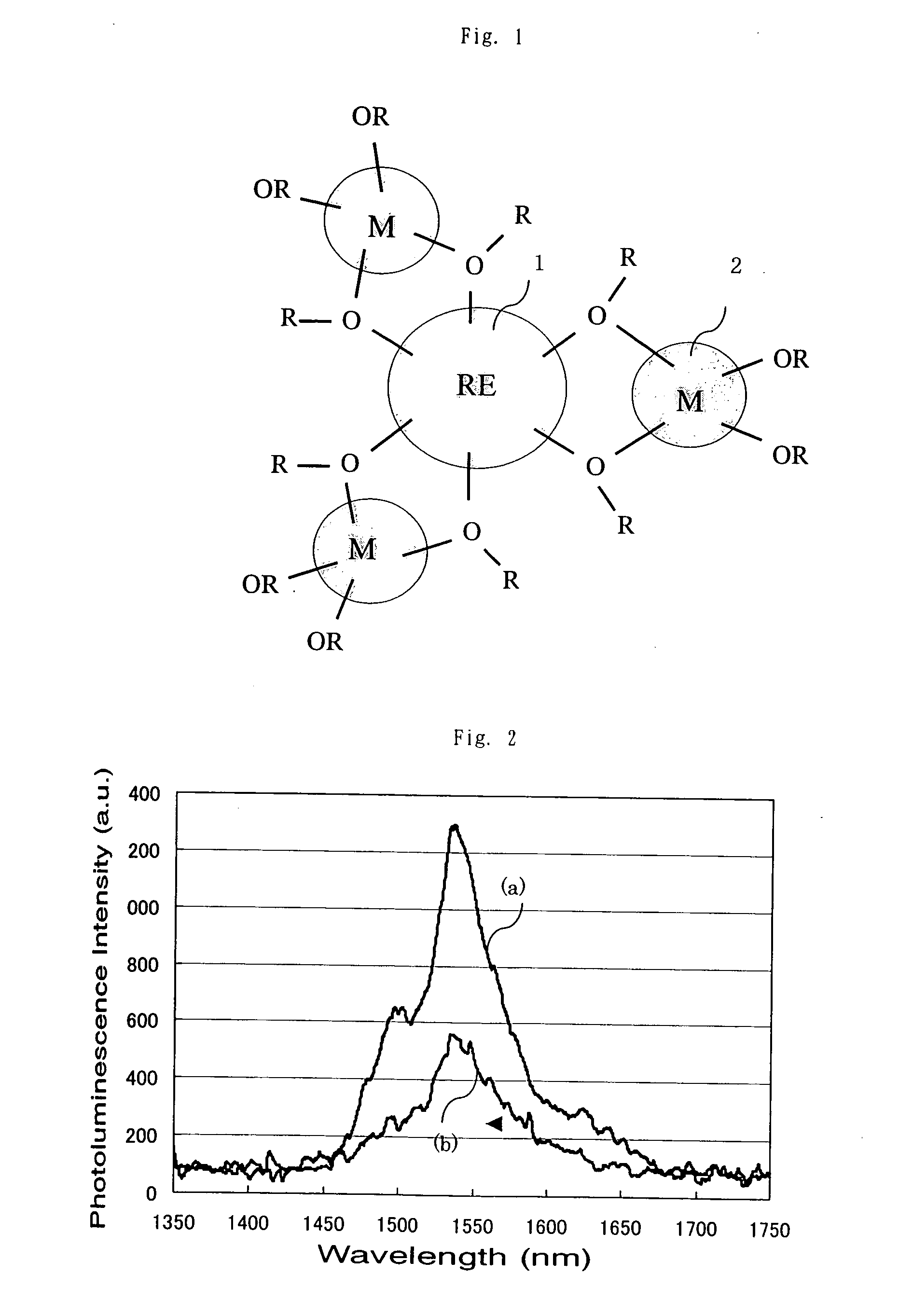Organic/Inorganic Composite
a composite material and organic technology, applied in the field of organic/inorganic composite materials, can solve the problems of no known material that can manifest optical, and achieve the effects of ensuring optical transparency, suppressing quenching, and high concentration
- Summary
- Abstract
- Description
- Claims
- Application Information
AI Technical Summary
Benefits of technology
Problems solved by technology
Method used
Image
Examples
example 1
[0135] Erbium acetate that had been dehydrated for 1 hour at 110° C. and tri-s-butoxy aluminum were added together in 2-butanol (Er / Al=3 molar, mathematically converted concentration of total oxides of Er and Al 5 mass %) and refluxed for 1 hour to obtain a light pink transparent liquid. The particle size of the reaction product obtained thereby was measured using dynamic light scattering, and it was confirmed that the reaction product comprised composite nanoparticles with a peak top of 1.7 nm in diameter. In addition, coordination of the Al via an oxygen atom(s) with the Er was verified before and after the reaction with tri-s-butoxy aluminum by the change in 27Al-NMR spectrum.
[0136]A photopolymerizable acrylic resin “Cyclomer” (Daicel Chemical Industries, Ltd.) was used as the transparent organic polymer. This organic polymer, the composite nanoparticles containing ErAl prepared according to the above method, and a photoradical initiator “Irgacure 369” (Ciba Specialty Chemicals) ...
example 2
Preparation of the Inorganic Dispersion Phase
[0139]Neodymium acetate that had been dehydrated under vacuum for 1 hour at 110° C. and tri-s-butoxy aluminum were added together in propylene glycol α-monomethyl ether (Nd / Al=3 molar, mathematically converted concentration of total oxides of Er and Al 5 mass %) and refluxed for 1 hour to obtain a light purple transparent liquid. The particle size of the reaction product obtained thereby was measured using dynamic light scattering, and it was confirmed that the reaction product comprised composite nanoparticles with a peak top of 2.3 nm in diameter. In addition, coordination of the Al via an oxygen atom(s) with the Nd was verified before and after the reaction with tri-s-butoxy aluminum by the change in 27Al-NMR spectrum.
[0140]Hydroxypropyl cellulose (Nippon Soda Co., Ltd.) was used as the transparent organic polymer. This organic polymer and the composite nanoparticles containing NdAl prepared according to the above method were mixed tog...
example 3
Preparation of the Inorganic Dispersion Phase
[0143]Neodymium acetate that had been dehydrated under vacuum for 1 hour at 110° C. and tri-s-butoxy aluminum were added together in propylene glycol α-monomethyl ether (Eu / Al=3 molar, mathematically converted concentration of total oxides of Eu and Al 5 mass %) and refluxed for 1 hour to obtain a colorless transparent liquid. The particle size of the reaction product obtained thereby was measured using dynamic light scattering, and it was confirmed that the reaction product comprised composite nanoparticles with a peak top of 1.5 nm in diameter. In addition, coordination of the Al via an oxygen atom(s) with the Eu was verified before and after the reaction with tri-s-butoxy aluminum by the change in 27Al-NMR spectrum.
[0144]Hydroxypropyl cellulose (Nippon Soda Co., Ltd.) was used as the transparent organic polymer. This organic polymer and the composite nanoparticles containing Eu—Al prepared according to the above method were mixed toget...
PUM
| Property | Measurement | Unit |
|---|---|---|
| particle diameter | aaaaa | aaaaa |
| diameter | aaaaa | aaaaa |
| particle size | aaaaa | aaaaa |
Abstract
Description
Claims
Application Information
 Login to View More
Login to View More - R&D
- Intellectual Property
- Life Sciences
- Materials
- Tech Scout
- Unparalleled Data Quality
- Higher Quality Content
- 60% Fewer Hallucinations
Browse by: Latest US Patents, China's latest patents, Technical Efficacy Thesaurus, Application Domain, Technology Topic, Popular Technical Reports.
© 2025 PatSnap. All rights reserved.Legal|Privacy policy|Modern Slavery Act Transparency Statement|Sitemap|About US| Contact US: help@patsnap.com



